Influence of Wave–Current Interaction on a Cyclone-Induced Storm Surge Event in the Ganges–Brahmaputra–Meghna Delta: Part 1—Effects on Water Level
Abstract
:1. Introduction
2. Field Site and Data
2.1. Cyclone Sidr
2.2. Study Area
2.3. Field Data
3. Methodology
3.1. Numerical Model Delft3D
3.1.1. Wave Setup
3.1.2. Wave-Current Interactions and Coupling Procedures
3.2. Model Setup and Boundary Forcings
3.3. Description of Scenarios
4. Result and Discussions
4.1. Model Validation
4.2. Surface Water Elevation Variations
4.3. Role of Tide, Wind, and Waves in the Storm Surge Height
4.4. Role of Wave-Current Interaction in Wave Setup
5. Summary and Conclusions
Author Contributions
Funding
Institutional Review Board Statement
Informed Consent Statement
Data Availability Statement
Acknowledgments
Conflicts of Interest
Appendix A
A.1. Model Domain and Bathymetry

A.2. Cyclone Wind and Pressure Field Incorporation
References
- Yu, X.; Pan, W.; Zheng, X.; Zhou, S.; Tao, X. Effects of wave-current interaction on storm surge in the Taiwan Strait: Insights from Typhoon Morakot. Cont. Shelf Res. 2017, 146, 47–57. [Google Scholar] [CrossRef]
- Roland, A.; Cucco, A.; Ferrarin, C.; Hsu, T.-W.W.; Liau, J.-M.M.; Ou, S.-H.H.; Umgiesser, G.; Zanke, U. On the development and verification of a 2-D coupled wave-current model on unstructured meshes. J. Mar. Syst. 2009, 78, S244–S254. [Google Scholar] [CrossRef]
- Kim, S.Y.; Yasuda, T.; Mase, H. Wave set-up in the storm surge along open coasts during Typhoon Anita. Coast. Eng. 2010, 57, 631–642. [Google Scholar] [CrossRef]
- Dietrich, J.C.; Zijlema, M.; Westerink, J.J.; Holthuijsen, L.H.; Dawson, C.; Luettich, R.A.; Jensen, R.E.; Smith, J.M.; Stelling, G.S.; Stone, G.W. Modeling hurricane waves and storm surge using integrally-coupled, scalable computations. Coast. Eng. 2011, 58, 45–65. [Google Scholar] [CrossRef]
- Brown, J.M.; Bolaños, R.; Wolf, J. The depth-varying response of coastal circulation and water levels to 2D radiation stress when applied in a coupled wave–tide–surge modelling system during an extreme storm. Coast. Eng. 2013, 82, 102–113. [Google Scholar] [CrossRef]
- Feng, X.; Yin, B.; Yang, D. Development of an unstructured-grid wave-current coupled model and its application. Ocean Model. 2016, 104, 213–225. [Google Scholar] [CrossRef]
- Tolman, H.L. Wind Wave Propagation in Tidal Seas. Ph.D. Thesis, Technische Universiteit Delft, Delft, The Netherlands, 1990. [Google Scholar]
- Zhang, W.-Z.; Shi, F.; Hong, H.-S.; Shang, S.-P.; Kirby, J.T. Tide-surge interaction intensified by the Taiwan Strait. J. Geophys. Res. Ocean. 2010, 115, 5762. [Google Scholar] [CrossRef]
- Xie, L.; Wu, K.; Pietrafesa, L.; Zhang, C. A numerical study of wave-current interaction through surface and bottom stresses: Wind-driven circulation in the South Atlantic Bight under uniform winds. J. Geophys. Res. Ocean. 2001, 106, 16841–16855. [Google Scholar] [CrossRef]
- Xie, L.; Pietrafesa, L.J.; Wu, K. A numerical study of wave-current interaction through surface and bottom stresses: Coastal ocean response to Hurricane Fran of 1996. J. Geophys. Res. Ocean. 2003, 108, 1–18. [Google Scholar] [CrossRef]
- Mastenbroek, C.; Burgers, G.; Janssen, P.A.E.M. The Dynamical Coupling of a Wave Model and a Storm Surge Model through the Atmospheric Boundary Layer. J. Phys. Oceanogr. 1993, 23, 1856–1866. [Google Scholar] [CrossRef]
- Signell, R.P.; Beardsley, R.C.; Graber, H.C.; Capotondi, A. Effect of wave-current interaction on wind-driven circulation in narrow, shallow embayments. J. Geophys. Res. Ocean. 1990, 95, 9671–9678. [Google Scholar] [CrossRef]
- Davies, A.M.; Lawrence, J. Modeling the Effect of Wave? Current Interaction on the Three-Dimensional Wind-Driven Circulation of the Eastern Irish Sea. J. Phys. Oceanogr. 1995, 25, 29–45. [Google Scholar] [CrossRef]
- Longuet-Higgins, M.S.; Stewart, R.W. Radiation stresses in water waves; a physical discussion, with applications. Deep Sea Res. Oceanogr. Abstr. 1964, 11, 529–562. [Google Scholar] [CrossRef]
- Smith, J.A. Wave-current interactions in finite depth. J. Phys. Oceanogr. 2006, 36, 1403–1419. [Google Scholar] [CrossRef]
- Longuet-Higgins, M.S.; Stewart, R.W. Radiation stress and mass transport in gravity waves, with application to ‘surf beats’. J. Fluid Mech. 1962, 13, 481–504. [Google Scholar] [CrossRef]
- Gonazález, F.I. A Case Study of Wave–Current–Bathymetry Interactions at the Columbia River Entrance. J. Phys. Oceanogr. 1984, 14, 1065–1078. [Google Scholar] [CrossRef]
- Wolf, J.; Prandle, D. Some observations of wave–current interaction. Coast. Eng. 1999, 37, 471–485. [Google Scholar] [CrossRef]
- Hopkins, J.; Elgar, S.; Raubenheimer, B. Observations and model simulations of wave-current interaction on the inner shelf. J. Geophys. Res. Ocean. 2016, 121, 198–208. [Google Scholar] [CrossRef]
- Mellor, G.L. The three-dimensional current and surface wave equations. J. Phys. Oceanogr. 2003, 33, 1978–1989. [Google Scholar] [CrossRef]
- Mellor, G.L.; Donelan, M.A.; Oey, L.Y. A surface wave model for coupling with numerical ocean circulation models. J. Atmos. Ocean. Technol. 2008, 25, 1785–1807. [Google Scholar] [CrossRef] [Green Version]
- Mellor, G. A Combined Derivation of the Integrated and Vertically Resolved, Coupled Wave-Current Equations. J. Phys. Oceanogr. 2015, 45, 1453–1463. [Google Scholar] [CrossRef]
- Resio, D.T.; Westerink, J.J. Modeling the physics of storm surges. Phys. Today 2008, 61, 33–38. [Google Scholar] [CrossRef]
- Raubenheimer, B.; Guza, R.T.; Elgar, S. Field observations of wave-driven setdown and setup. J. Geophys. Res. Ocean. 2001, 106, 4629–4638. [Google Scholar] [CrossRef]
- Malhadas, M.S.; Leitão, P.C.; Silva, A.; Neves, R. Effect of coastal waves on sea level in Óbidos Lagoon, Portugal. Cont. Shelf Res. 2009, 29, 1240–1250. [Google Scholar] [CrossRef]
- Feng, X.; Yin, B.; Yang, D. Effect of hurricane paths on storm surge response at Tianjin, China. Estuar. Coast. Shelf Sci. 2012, 106, 58–68. [Google Scholar] [CrossRef]
- Lewis, M.J.; Palmer, T.; Hashemi, R.; Robins, P.; Saulter, A.; Brown, J.; Lewis, H.; Neill, S. Wave-tide interaction modulates nearshore wave height. Ocean Dyn. 2019, 69, 367–384. [Google Scholar] [CrossRef]
- Zheng, J.; Yao, Y.; Chen Songgui Chen Shubin Zhang, Q. Laboratory study on wave-induced setup and wave-driven current in a 2DH reef-lagoon-channel system. Coast. Eng. 2020, 162, 103772. [Google Scholar] [CrossRef]
- Song, H.; Kuang, C.; Hua, X.; Ma, Z. Wave-current interactions during extreme weather conditions in southwest of Bohai Bay, China. Ocean Eng. 2020, 216, 108068. [Google Scholar] [CrossRef]
- Hoeke, R.K.; McInnes, K.L.; O’Grady, J.G. Wind and Wave Setup Contributions to Extreme Sea Levels at a Tropical High Island: A Stochastic Cyclone Simulation Study for Apia, Samoa. J. Mar. Sci. Eng. 2015, 3, 1117. [Google Scholar] [CrossRef]
- Drost, E.J.F.; Lowe, R.J.; Ivey, G.N.; Jones, N.L. Wave-current interactions in the continental shelf bottom boundary layer of the Australian North West Shelf during tropical cyclone conditions. Cont. Shelf Res. 2018, 165, 78–92. [Google Scholar] [CrossRef]
- Mao, M.; Xia, M. Dynamics of wave–current–surge interactions in Lake Michigan: A model comparison. Ocean Model. 2017, 110, 1–20. [Google Scholar] [CrossRef]
- Mao, M.; Xia, M. Wave–current dynamics and interactions near the two inlets of a shallow lagoon–inlet–coastal ocean system under hurricane conditions. Ocean Model. 2018, 129, 124–144. [Google Scholar] [CrossRef]
- Prakash, K.R.; Pant, V. On the wave-current interaction during the passage of a tropical cyclone in the Bay of Bengal. Deep Sea Res. Part II Top. Stud. Oceanogr. 2020, 172, 104658. [Google Scholar] [CrossRef]
- Jullien, S.; Aucan, J.; Lefèvre, J.; Peltier, A.; Menkes, C.E. Tropical Cyclone Induced Wave Setup around New Caledonia during Cyclone COOK (2017). J. Coast. Res. 2020, 95, 1454–1459. [Google Scholar] [CrossRef]
- McPhaden, M.J.; Foltz, G.R.; Lee, T.; Murty, V.S.N.; Ravichandran, M.; Vecchi, G.A.; Vialard, J.; Wiggert, J.D.; Yu, L. Ocean-Atmosphere Interactions During Cyclone Nargis. Eos Trans. Am. Geophys. Union 2009, 90, 53–54. [Google Scholar] [CrossRef]
- Saiful, I.A.; Kumar, B.S.; Asad, H.M.; Abed, H.M.; Mafizur, R.M. Performance of Coastal Structures during Cyclone Sidr. Nat. Hazards Rev. 2011, 12, 111–116. [Google Scholar] [CrossRef]
- Rahman, S.; Islam, A.K.M.S.M.S.; Saha, P.; Tazkia, A.R.; Krien, Y.; Durand, F.; Testut, L.; Islam, G.M.T.T.; Bala, S.K. Projected changes of inundation of cyclonic storms in the Ganges--Brahmaputra--Meghna delta of Bangladesh due to SLR by 2100. J. Earth Syst. Sci. 2019, 128, 145. [Google Scholar] [CrossRef]
- Deb, M.; Ferreira, C.M. Simulation of cyclone-induced storm surges in the low-lying delta of Bangladesh using coupled hydrodynamic and wave model (SWAN + ADCIRC). J. Flood Risk Manag. 2016, 11, S555–S1136. [Google Scholar] [CrossRef]
- Sinha, P.C.; Rao, Y.R.; Dube, S.K.; Rao, A.D.; Chatterjee, A.K. Numerical investigation of tide-surge interaction in hooghly estuary, India. Mar. Geod. 1996, 19, 235–255. [Google Scholar] [CrossRef]
- As-Salek, J.A. Coastal Trapping and Funneling Effects on Storm Surges in the Meghna Estuary in Relation to Cyclones Hitting Noakhali–Cox’s Bazar Coast of Bangladesh. J. Phys. Oceanogr. 1998, 28, 227–249. [Google Scholar] [CrossRef]
- Dube, S.K.; Rao, A.D.; Sinha, P.C.; Murty, T.S.; Bahulayan, N. Storm surge in the Bay of Bengal and Arabian Sea the problem and its prediction. Mausam 1997, 48, 283–304. [Google Scholar] [CrossRef]
- Dube, S.K. Prediction of Storm Surges in the Bay of Bengal. Trop. Cyclone Res. Rev. 2012, 1, 67–74. [Google Scholar] [CrossRef]
- Dube, S.K.; Chittibabu, P.; Sinha, P.C.; Rao, A.D.; Murty, T.S. Numerical Modelling of Storm Surge in the Head Bay of Bengal Using Location Specific Model. Nat. Hazards 2004, 31, 437–453. [Google Scholar] [CrossRef]
- Dube, S.K.; Jain, I.; Rao, A.D.; Murty, T.S. Storm surge modelling for the Bay of Bengal and Arabian Sea. Nat. Hazards 2009, 51, 3–27. [Google Scholar] [CrossRef]
- Lewis, M.; Bates, P.; Horsburgh, K.; Neal, J.; Schumann, G. A storm surge inundation model of the northern Bay of Bengal using publicly available data. Q. J. R. Meteorol. Soc. 2013, 139, 358–369. [Google Scholar] [CrossRef]
- Lewis, M.; Horsburgh, K.; Bates, P. Bay of Bengal cyclone extreme water level estimate uncertainty. Nat. Hazards 2014, 72, 983–996. [Google Scholar] [CrossRef]
- Kumar, T.S.; Murty, P.L.N.; Kumar, M.P.; Kumar, M.K.; Padmanabham, J.; Kumar, N.K.; Shenoi, S.C.; Mohapatra, M.; Nayak, S.; Mohanty, P. Modeling Storm Surge and its Associated Inland Inundation Extent Due to Very Severe Cyclonic Storm Phailin. Mar. Geod. 2015, 38, 345–360. [Google Scholar] [CrossRef]
- Krien, Y.; Testut, L.; Islam, A.K.M.S.; Bertin, X.; Durand, F.; Mayet, C.; Tazkia, A.R.; Becker, M.; Calmant, S.; Papa, F.; et al. Towards improved storm surge models in the northern Bay of Bengal. Cont. Shelf Res. 2017, 135, 58–73. [Google Scholar] [CrossRef]
- Dube, S.K.; Rao, A.D.; Sinha, P.C.; Chittibabu, P. A Real Time Storm Surge Prediction System: An Application to East Coast of India. Proc. Indian Natl. Sci. Acad. 1994, 60, 157–170. [Google Scholar]
- Flather, R.A. Storm Surges. In The Cytokine Factsbook; Academic Press: Cambridge, MA, USA, 2001; pp. 2882–2892. [Google Scholar] [CrossRef]
- Rego, J.L.; Li, C. Nonlinear terms in storm surge predictions: Effect of tide and shelf geometry with case study from Hurricane Rita. J. Geophys. Res. Ocean. 2010, 115. [Google Scholar] [CrossRef] [Green Version]
- Kennedy, A.B.; Westerink, J.J.; Smith, J.M.; Hope, M.E.; Hartman, M.; Taflanidis, A.A.; Tanaka, S.; Westerink, H.; Cheung, K.F.; Smith, T.; et al. Tropical cyclone inundation potential on the Hawaiian Islands of Oahu and Kauai. Ocean Model. 2012, 52—53, 54–68. [Google Scholar] [CrossRef]
- Samiksha, V.; Vethamony, P.; Antony, C.; Bhaskaran, P.; Nair, B. Wave-current interaction during Hudhud cyclone in the Bay of Bengal. Nat. Hazards Earth Syst. Sci. 2017, 17, 2059–2074. [Google Scholar] [CrossRef]
- Ris, R.C.; Holthuijsen, L.H.; Booij, N. A third-generation wave model for coastal regions: 2. Verification. J. Geophys. Res. Ocean. 1999, 104, 7667–7681. [Google Scholar] [CrossRef]
- Pleskachevsky, A.; Eppel, D.P.; Kapitza, H. Interaction of waves, currents and tides, and wave-energy impact on the beach area of Sylt Island. Ocean Dyn. 2009, 59, 451–461. [Google Scholar] [CrossRef]
- Murty, P.L.N.N.; Sandhya, K.G.; Bhaskaran, P.K.; Jose, F.; Gayathri, R.; Balakrishnan Nair, T.M.; Srinivasa Kumar, T.; Shenoi, S.S.C. A coupled hydrodynamic modeling system for PHAILIN cyclone in the Bay of Bengal. Coast. Eng. 2014, 93, 71–81. [Google Scholar] [CrossRef]
- Flather, R.A. A Storm Surge Prediction Model for the Northern Bay of Bengal with Application to the Cyclone Disaster in April 1991. J. Phys. Oceanogr. 1994, 24, 172–190. [Google Scholar] [CrossRef]
- Hussain, M.A.; Tajima, Y. Numerical investigation of surge–tide interactions in the Bay of Bengal along the Bangladesh coast. Nat. Hazards 2017, 86, 669–694. [Google Scholar] [CrossRef]
- Alam, E.; Collins, A.E. Cyclone disaster vulnerability and response experiences in coastal Bangladesh. Disasters 2010, 34, 931–954. [Google Scholar] [CrossRef]
- Snead, R.E. Bangladesh. In Encyclopedia of the World’s Coastal Landforms; Bird, E.C.F., Ed.; Springer: Dordrecht, The Netherlands, 2010; pp. 1077–1080. [Google Scholar] [CrossRef]
- Elahi, M.W.E.; Jalón-Rojas, I.; Wang, X.H.; Ritchie, E.A. Influence of Seasonal River Discharge on Tidal Propagation in the Ganges-Brahmaputra-Meghna Delta, Bangladesh. J. Geophys. Res. Ocean. 2020, 125, e2020JC016417. [Google Scholar] [CrossRef]
- Rogers, K.G.; Goodbred, S.L. The Sundarbans and Bengal Delta: The World’s Largest Tidal Mangrove and Delta System. In Landscapes and Landforms of India; Kale, V.S., Ed.; Springer: Berlin/Heidelberg, Germany, 2014; pp. 181–187. [Google Scholar] [CrossRef]
- Paul, B.K. Why relatively fewer people died? The case of Bangladesh’s Cyclone Sidr. Nat. Hazards 2009, 50, 289–304. [Google Scholar] [CrossRef]
- Chiu, S.; Small, C. Observations of Cyclone-Induced Storm Surge in Coastal Bangladesh. J. Coast. Res. 2016, 321, 1149–1161. [Google Scholar] [CrossRef]
- Dee, D.P.; Uppala, S.M.; Simmons, A.J.; Berrisford, P.; Poli, P.; Kobayashi, S.; Andrae, U.; Balmaseda, M.A.; Balsamo, G.; Bauer, P.; et al. The ERA-Interim reanalysis: Configuration and performance of the data assimilation system. Q. J. R. Meteorol. Soc. 2011, 137, 553–597. [Google Scholar] [CrossRef]
- Lesser, G.R.; Roelvink, J.A.; van Kester, J.A.T.M.; Stelling, G.S. Development and validation of a three-dimensional morphological model. Coast. Eng. 2004, 51, 883–915. [Google Scholar] [CrossRef]
- Deltares. Delft3d-FLOW: Simulation of Multi-Dimensional Hydrodynamic Flows and Transport Phenomena, Including Sediments; MH Delft: Delft, The Netherlands, 2021. [Google Scholar]
- Booij, N.; Ris, R.C.; Holthuijsen, L.H. A third-generation wave model for coastal regions 1. Model description and validation. J. Geophys. Res. Ocean. 1999, 104, 7649–7666. [Google Scholar] [CrossRef]
- Deltares. Simulation of Short-Creseted Waves with SWAN: Deflt3D-WAVE, User Manual; Deltares: Delft, Netherlands, 2018. [Google Scholar]
- Cats, G. Numerical Modeling of Wave-Current Interaction with the Use of a Two Way Coupled System. Master’s Thesis, Delft University of Technology, Delft, The Netherlands, 2014. [Google Scholar]
- Jørgen, F. Turbulent Boundary Layer in Wave-current Motion. J. Hydraul. Eng. 1984, 110, 1103–1120. [Google Scholar] [CrossRef]
- Fredsøe, J.; Deigaard, R. Mechanics of Coastal Sediment Transport; World Scientific: Singapore, 1992. [Google Scholar]
- Groeneweg, J.; Battjes, J.A. Three-dimensional wave effects on a steady current. J. Fluid Mech. 2003, 478, 325–343. [Google Scholar] [CrossRef]
- Battjes, J.; Janssen, J. Energy Loss and Set-Up Due to Breaking of Random Waves. Int. Conf. Coastal. Eng. 1978, 1, 32. [Google Scholar] [CrossRef]
- Egbert, G.D.; Erofeeva, S.Y. Efficient Inverse Modeling of Barotropic Ocean Tides. J. Atmos. Ocean. Technol. 2002, 19, 183–204. [Google Scholar] [CrossRef]
- Ormondt, M.; Nederhoff, K.; van Dongeren, A. Delft dashboard: A quick set-up tool for hydrodynamic models. J. Hydroinform. 2020, 22, 510–527. [Google Scholar] [CrossRef]
- Holland, G.J.; Belanger, J.I.; Fritz, A. A revised model for radial profiles of hurricane winds. Mon. Weather Rev. 2010, 138, 4393–4401. [Google Scholar] [CrossRef]
- Ikeuchi, H.; Hirabayashi, Y.; Yamazaki, D.; Muis, S.; Ward, P.J.; Winsemius, H.C.; Verlaan, M.; Kanae, S. Compound simulation of fluvial floods and storm surges in a global coupled river-coast flood model: Model development and its application to 2007 Cyclone Sidr in Bangladesh. J. Adv. Model. Earth Syst. 2017, 9, 1847–1862. [Google Scholar] [CrossRef]
- Hersbach, H.; Bell, B.; Berrisford, P.; Hirahara, S.; Horányi, A.; Muñoz-Sabater, J.; Nicolas, J.; Peubey, C.; Radu, R.; Schepers, D.; et al. The ERA5 global reanalysis. Q. J. R. Meteorol. Soc. 2020, 146, 1999–2049. [Google Scholar] [CrossRef]
- Wang, X.H.; Elahi, M.W.E. Influence of Wave–Current Interaction on a Cyclone-Induced Storm-Surge Event in the Ganges-Brahmaputra-Meghna Delta: Part 2—Effects on Wave. J. Mar. Sci. Eng. 2023, 11, 298. [Google Scholar] [CrossRef]
- Bhaskaran, P.K.; Rao, A.D.; Murty, T. Tropical Cyclone-Induced Storm Surges and Wind Waves in the Bay of Bengal, Techniques for Disaster Risk Management and Mitigation; John Wiley & Sons: Hoboken, NJ, USA, 2020. [Google Scholar] [CrossRef]
- Deltares. Wind Enhance Scheme for Cyclone Modelling; MH Delft: Delft, The Netherlands, 2021. [Google Scholar]
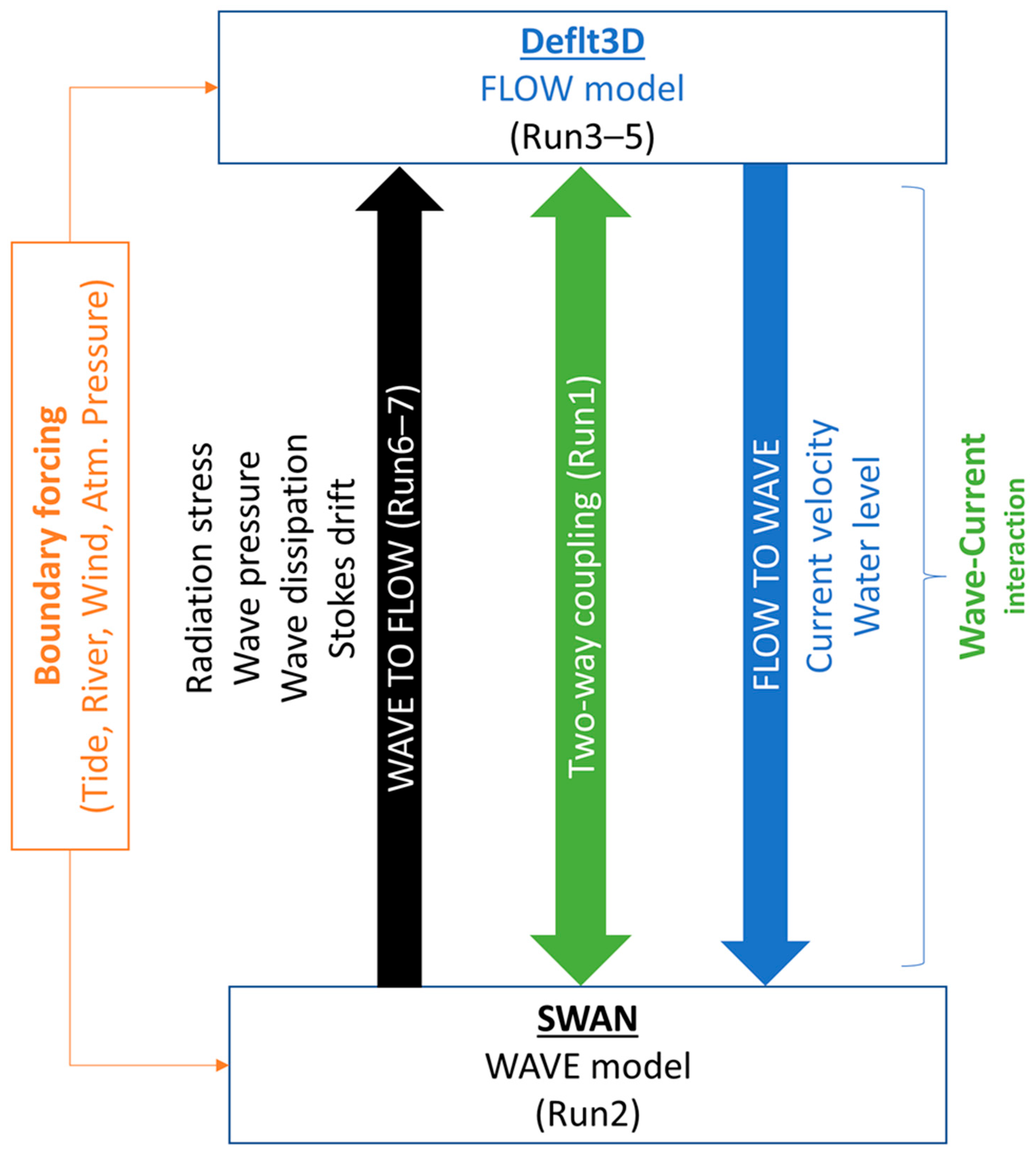
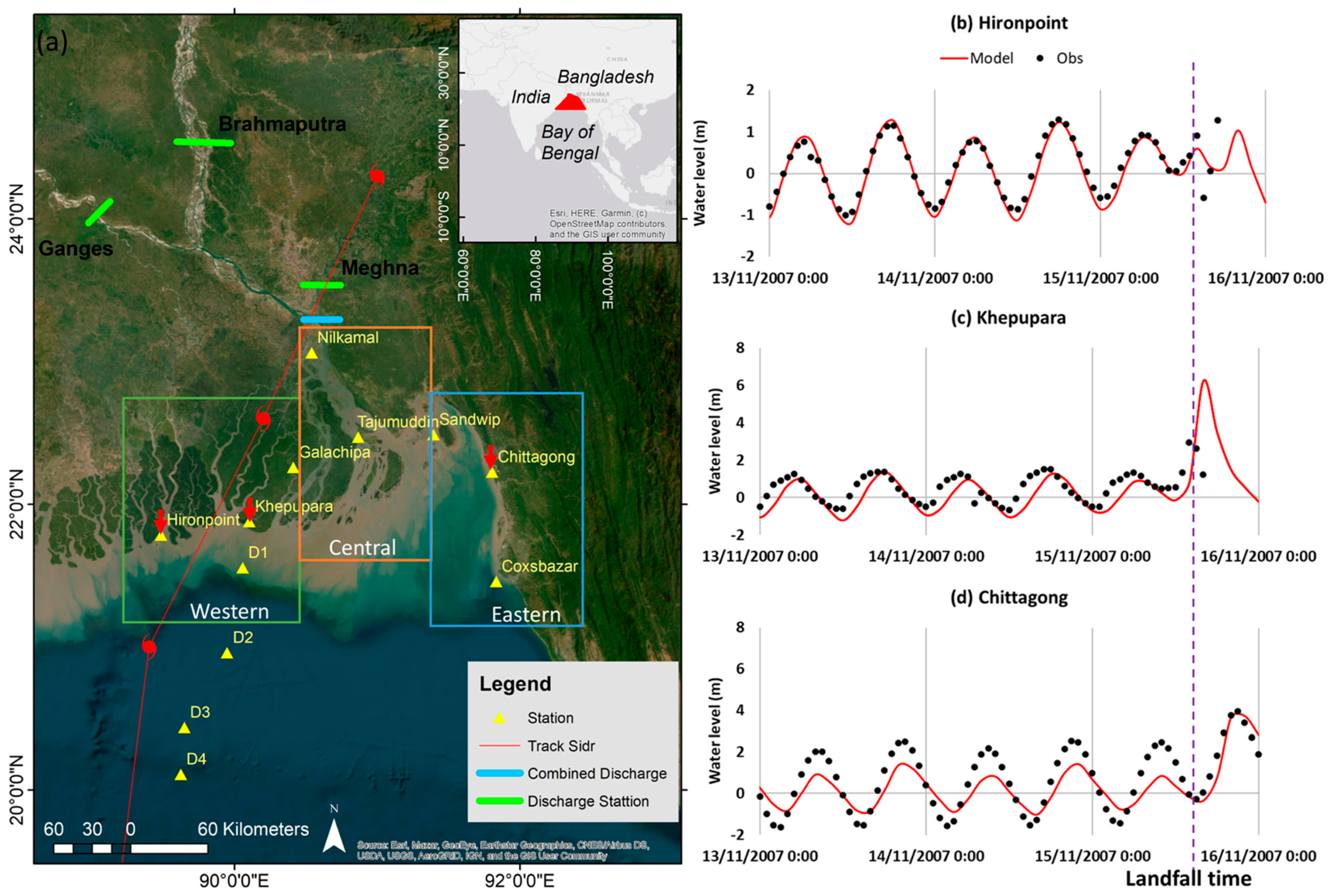
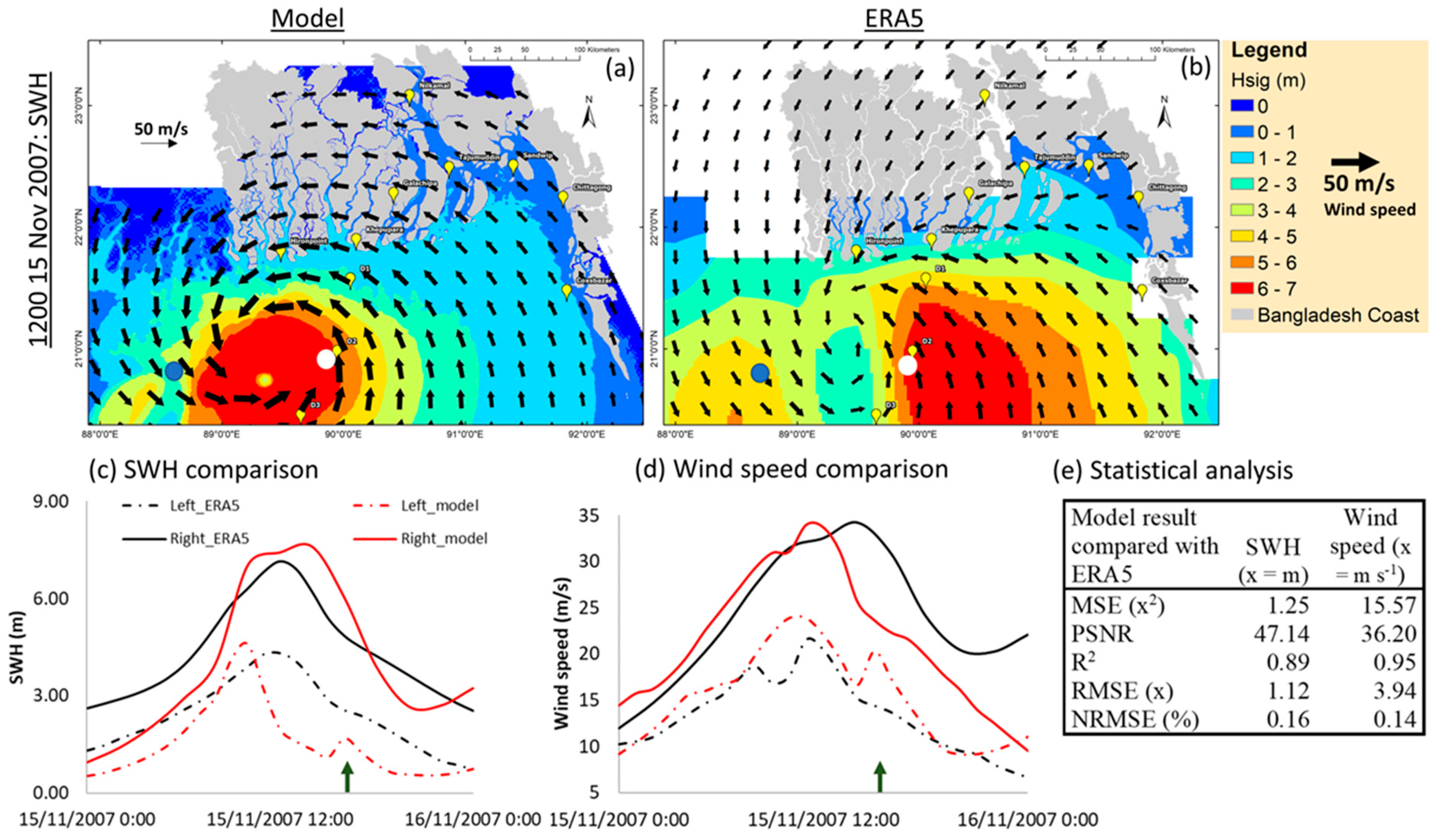


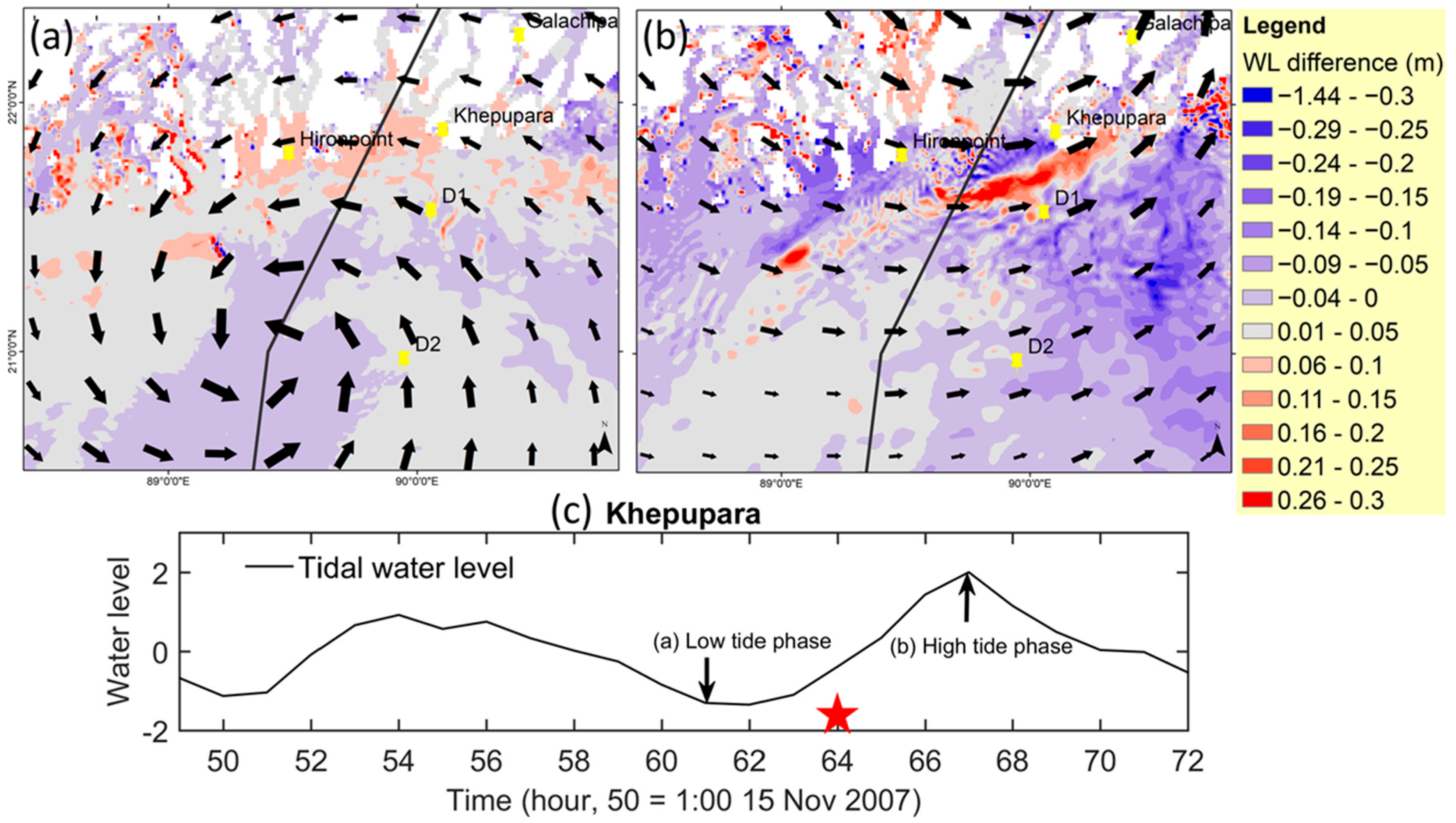
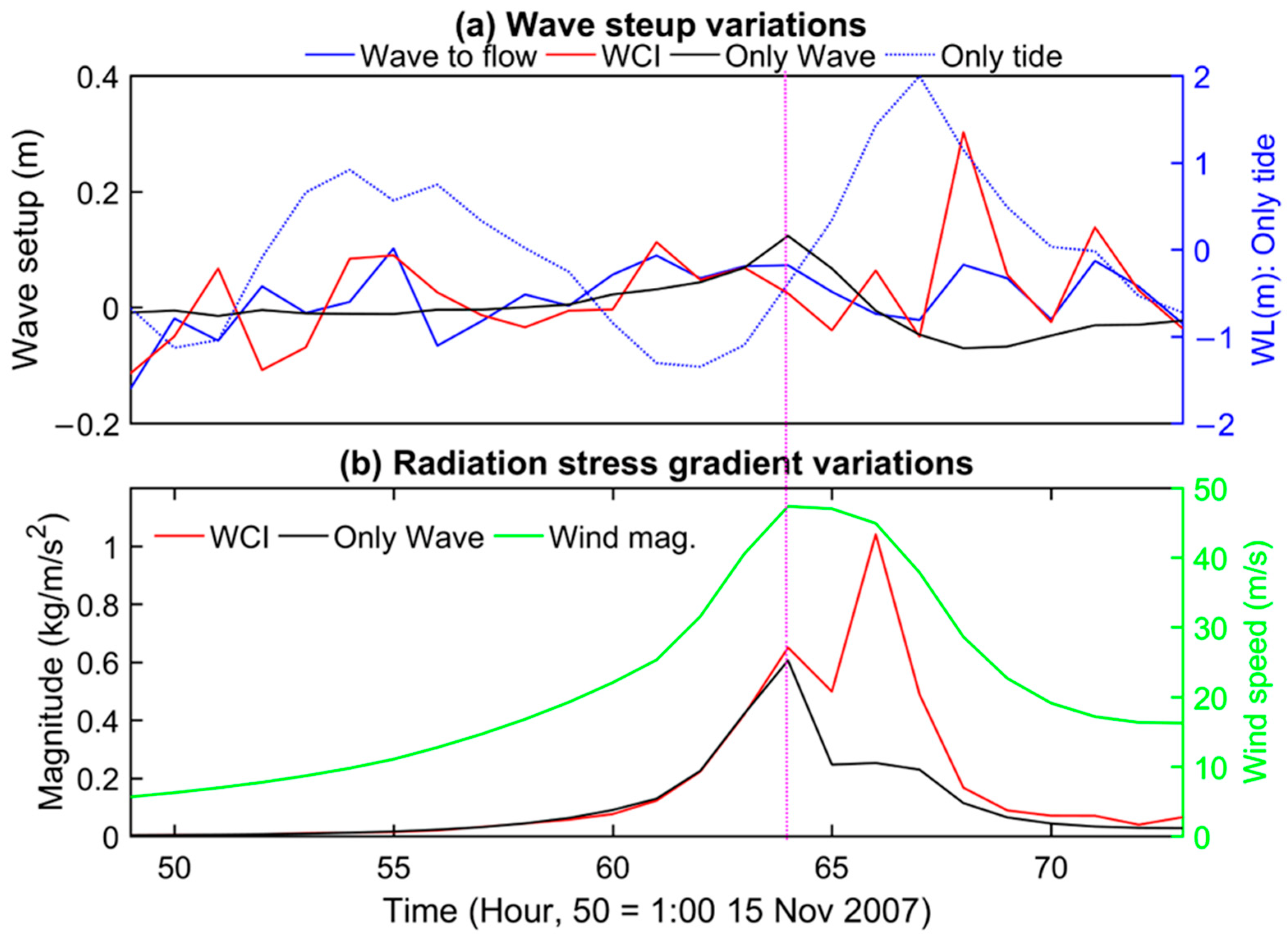
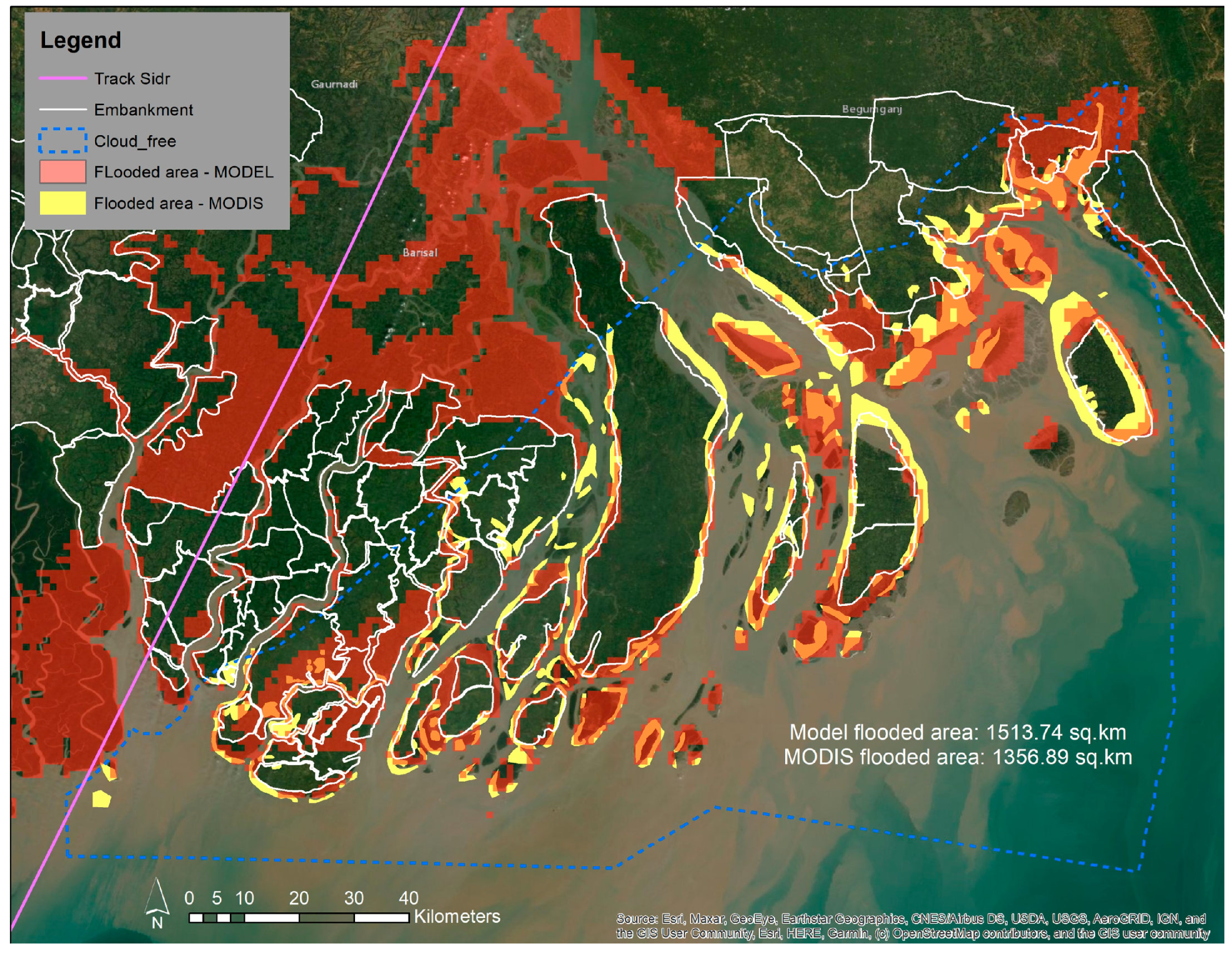
| Delft3d FLOW | ||
|---|---|---|
| Parameters | Model | Coefficients |
| Bottom roughness | Manning | 0.00025–0.05 (sea to land) |
| Stress formulation | Fredsoe, 1984 | |
| Background horizontal viscosity/diffusivity | - | 1 m2 s−1 |
| Background vertical viscosity/diffusivity | 0.1 m2 s−1 | |
| Model for 3D turbulence | k-Epsilon | |
| Wind drag coefficients | 0.001 for U10 = 0 m s−1 0.003 for U10 = 30 m s−1 | |
| Time step | 0.5 min | |
| SWAN | ||
| Generation mode for physics | 3-rd generation | |
| Depth-induced breaking | B&J model (Battjes and Janssen, 1978) | Alpha = 1, Gamma = 0.73 |
| Non-linear triad interaction | - | Alpha = 0.1, Beta = 2.2 |
| Bottom friction | JONSWAP | Coef. = 0.08 m2 s−3 |
| Diffraction | - | Smoothing coef. = 0.2 Smoothing steps = 5 Adapt propagation = Yes |
| Other processes activated in SWAN | ||
| Wind growth | Yes | |
| Whitecapping | Yes (following Komen et al., 1984) | |
| Wave propagation in spectral space | Refraction and Frequency shift are activated | |
| Experiment Designed to Study Wave Influence | |||
|---|---|---|---|
| Run Name | Simulation | Description | Coupling Method |
| Run1 | Control run | FLOW and WAVE simulation | Two-way |
| Run2 | Wave only | WAVE simulation | No coupling |
| Run3 | Current only (tide) | FLOW simulation with only tide forcing | No coupling |
| Run4 | Current only (Wind) | FLOW simulation with only wind forcing | No coupling |
| Run5 | Current only (Tide and Wind) | FLOW simulation with tide and wind forcing | No coupling |
| Run6 | Current only (Tide and Wind with Wave) | FLOW simulation using only radiation stress from Run2 | One-way (WAVE to FLOW) |
| Run7 | Current only (Ignoring Tide and Wind, only wave-driven current) | FLOW simulation using only radiation stress from Run2 | One-way (WAVE to FLOW) |
| (Water Level) | Hironpoint | Khepupara | Chittagong |
|---|---|---|---|
| MSE: Mean squared error (m2) | 0.08 | 0.46 | 0.74 |
| PSNR: Peak signal-to-noise ratio | 59.37 | 51.50 | 49.41 |
| R sq. value: | 0.84 | 0.44 | 0.71 |
| RMSE: Root mean square deviation (m): | 0.27 | 0.68 | 0.86 |
| NRMSE: Normalized Root-mean-square error (%) | 0.12 | 0.19 | 0.15 |
| Locations | Chittagong | Coxsbazar | Sandwip | Khepu Para | Galachipa | Hironpoint | R2 | RMSE (m) |
|---|---|---|---|---|---|---|---|---|
| Lat | 22.19 | 21.46 | 22.48 | 21.88 | 22.03 | 21.81 | ||
| Long | 91.81 | 91.92 | 91.55 | 90.10 | 90.34 | 89.49 | ||
| High water level during cyclone Sidr (m) | ||||||||
| This study | 4.8 | 2.4 | 6.1 | 6.5 | 5.4 | 1.2 | ||
| Deb and Ferreira, 2016 | 3 | 2.0 | 4.5 | 5.9 | 6.5 | 2.5 | 0.92 | 1.23 |
| Lewis et al., 2013 | 3.2 | 2.0 | 3.4 | 5.5 | 6.1 | 2.5 | 0.87 | 1.48 |
| Maximum significant wave height during cyclone Sidr (m) | ||||||||
| This study | 1.7 | 1.6 | 2.2 | 2.9 | 1.6 | 3.1 | ||
| Deb and Ferreira, 2016 | 3.2 | 1.8 | 3.1 | 2.1 | 3 | 3 | 0.87 | 0.97 |
Disclaimer/Publisher’s Note: The statements, opinions and data contained in all publications are solely those of the individual author(s) and contributor(s) and not of MDPI and/or the editor(s). MDPI and/or the editor(s) disclaim responsibility for any injury to people or property resulting from any ideas, methods, instructions or products referred to in the content. |
© 2023 by the authors. Licensee MDPI, Basel, Switzerland. This article is an open access article distributed under the terms and conditions of the Creative Commons Attribution (CC BY) license (https://creativecommons.org/licenses/by/4.0/).
Share and Cite
Elahi, M.W.E.; Wang, X.H.; Salcedo-Castro, J.; Ritchie, E.A. Influence of Wave–Current Interaction on a Cyclone-Induced Storm Surge Event in the Ganges–Brahmaputra–Meghna Delta: Part 1—Effects on Water Level. J. Mar. Sci. Eng. 2023, 11, 328. https://doi.org/10.3390/jmse11020328
Elahi MWE, Wang XH, Salcedo-Castro J, Ritchie EA. Influence of Wave–Current Interaction on a Cyclone-Induced Storm Surge Event in the Ganges–Brahmaputra–Meghna Delta: Part 1—Effects on Water Level. Journal of Marine Science and Engineering. 2023; 11(2):328. https://doi.org/10.3390/jmse11020328
Chicago/Turabian StyleElahi, Md Wasif E, Xiao Hua Wang, Julio Salcedo-Castro, and Elizabeth A. Ritchie. 2023. "Influence of Wave–Current Interaction on a Cyclone-Induced Storm Surge Event in the Ganges–Brahmaputra–Meghna Delta: Part 1—Effects on Water Level" Journal of Marine Science and Engineering 11, no. 2: 328. https://doi.org/10.3390/jmse11020328





